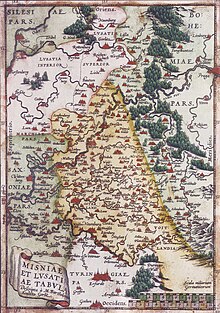Margraviate of Meissen

The Margraviate of Meißen was a medieval principality in the area of today's federal state of Saxony , the actual Upper Saxony or the Meißnischer Kreis , which emerged from the Mark Thuringia in the course of the German East Settlement .
history
During a campaign against the Slavic Daleminzier , King Heinrich I had a castle built on a hill on the Elbe in 928/929 , which was named after the Meisa brook flowing below (or a Slavic village of the same name). The castle was probably lost again immediately after the withdrawal of the Saxon army, because there are no reports about Meissen from the period from 929 to 968. In the foundation deed of the Archdiocese of Magdeburg , three margraves , Wigbert , Gunther von Merseburg and Wigger I, are attested once for the year 968 , of whom it is assumed that either Gunther or Wigbert had their seat in Meissen. However, there is no evidence of the existence of a margravate. In the same year, the castle hill became the seat of the bishop of the new diocese of Meissen . The city of Meissen developed at the foot of the castle . There is also evidence of a burgrave since 1068 . Over time, a Burgraviate of Meissen developed, which the Meinheringer family was able to expand further.
The domain of the Margraves of Meißen, on the other hand, extended in the course of the 11th century to the Neisse , later also in a southerly direction into the Ore Mountains . For the year 983 a certain Rikdag is documented as margrave , since 985 the family of the Ekkehardinger . Due to the Peace of Bautzen , however, the first temporary and later final separation of the Milzenerland , later Upper Lusatia , from the margraviate took place between 1018 and 1031 .


In 1046 the margraviate came to the family of the Weimar-Orlamünder counts, and in 1067 to the Brunones , whose representative Ekbert II was deposed in the investiture dispute in 1089. He was followed in the same year by Heinrich I von Eilenburg (1089–1103) from the Wettin family , under whose rule the margraviate was to remain from now on. Especially under the margraves Konrad (1123–1156), Otto (1156–1190) and Dietrich (1190 / 1197–1221) the margraviate was expanded and developed. The attempt of Emperor Heinrich VI. to withdraw the Margraviate of Meißen for the empire again in 1195, but this was averted after his death.
Heinrich the Illustrious (1221–1288) was able to prevail in 1264 in the inheritance dispute over the Landgraviate of Thuringia , where his uncle Heinrich Raspe died childless in 1247, and thereby add Thuringia to the Wettin possessions. In 1243/1255 Heinrich the illustrious first acquired the Pleißenland around Altenburg as a pledge, which enabled him to combine the Wettin property in the margraviate of Meißen with the property in Thuringia and older Wettin counties. An attempt by the king to take back the margraviate of Meissen as a fiefdom failed in 1307 with the battle of Lucka .
In the period that followed, several male relatives of the Wettins were reunited , and in 1382 and 1445 the territories that belonged to the Margraviate of Meissen, the Landgraviate of Thuringia and the Pleißenland were even divided. After individual family lines became extinct, these areas repeatedly collapsed. At the same time, the territory could be expanded through marriage, monetary payments or military force (e.g. in the Dohna feud ), and in 1426 the rights to the Burgraviate of Meissen again. At the end of the 15th century, the Wettins ruled over more or less contiguous areas between the Werra and the Oder .
In 1423 the Duchy of Saxony-Wittenberg was transferred to the Margrave of Meißen Friedrich the Arguing , with which the electoral dignity was connected. As a result, the Margraviate of Meissen became part of the Electorate of Saxony and lost its status as an independent principality. The division of Leipzig in 1485 between the brothers Ernst and Albrecht led to the separation into an Ernestine and an Albertine Saxony. The successor states of the former are, along with other states, forerunners of today's state of Thuringia and those of the latter for the state of Saxony , which also includes the core area of the margraviate.
The Albertines, elector of Saxony from 1547 and Saxon kings from 1806 , continued the title of margrave of Meissen (among many other titles). Prince Friedrich Christian (1893–1968), son of the last Saxon king and head of the Albertine line of the Wettin family (from 1932) informally (i.e. without a formal name change) assumed this title again to document his position as head of the Albertines. As such, he was followed by his eldest son Maria Emanuel Margrave of Meißen (1926–2012). Since then, a dispute has broken out over the position as head of the former Royal House of Saxony .
scope
Originally, the margraviate of Meißen only included the old settlements of the burgraviate (roughly comparable to the later district of Meißen ). In the 12th and 13th centuries, further parts were added, so that the margraviate of Meißen finally extended into the Ore Mountains and the Leipziger Land . In 1547, Elector Moritz divided his territory into five districts: the Kurkreis , the Thuringian District , the Leipzig District , the Meißnische Kreis and the Erzgebirge District . The Leipzig District, the Meißnische District and the Erzgebirge District emerged from the old Margraviate of Meißen.
literature
- Matthias Donath : Sächsisches Elbland , Series Cultural Landscapes of Saxony Volume 1, Edition Leipzig, Leipzig 2009
- Karl Friedrich von Posern-Klett: On the history of the constitution of the Margraviate of Meissen in the 13th century. Preliminary studies on a Saxon state and legal history . Weigel, Leipzig 1863. ( digitized version )
- Otto Eduard Schmidt : From the old Mark Meißen . Series Kursächsische Streifzüge, Volume 3, Dresden 1924
- Heinz Weise (Ed.): Mark Meissen: from Meissen's power to Saxony's splendor. Brockhaus, Leipzig 1989, ISBN 3-325-00188-2
- Leo Bönhoff : "The oldest offices of the Mark Meißen", in: "New Archive for Saxon History 38", 1917, pp. 17–45
See also
Web links
Remarks
- ↑ Renate Koch: On the history of the Mark Meissen and the district of Dresden-Land. In: Renate Koch , Herbert Wagner : The history of local politics in Saxony: From the peaceful revolution to the present . W. Kohlhammer Verlag, Dresden 2006, ISBN 3-555-54038-6 , pp. 173 ( limited preview in Google Book search).
- ^ Gertraud Eva Schrage: On the settlement policy of the Ottonians. Studies on the integration of the areas east of the Saale in the 10th century. In: sheets for German national history. Vol. 135, 1999, pp. 189-268, p. 204.
- ↑ Gabriele Rupp: The Ekkehardiner, Margraves of Meißen, and their relations to the empire and the Piasts . Lang, Frankfurt am Main 1996, pp. 44-47.
